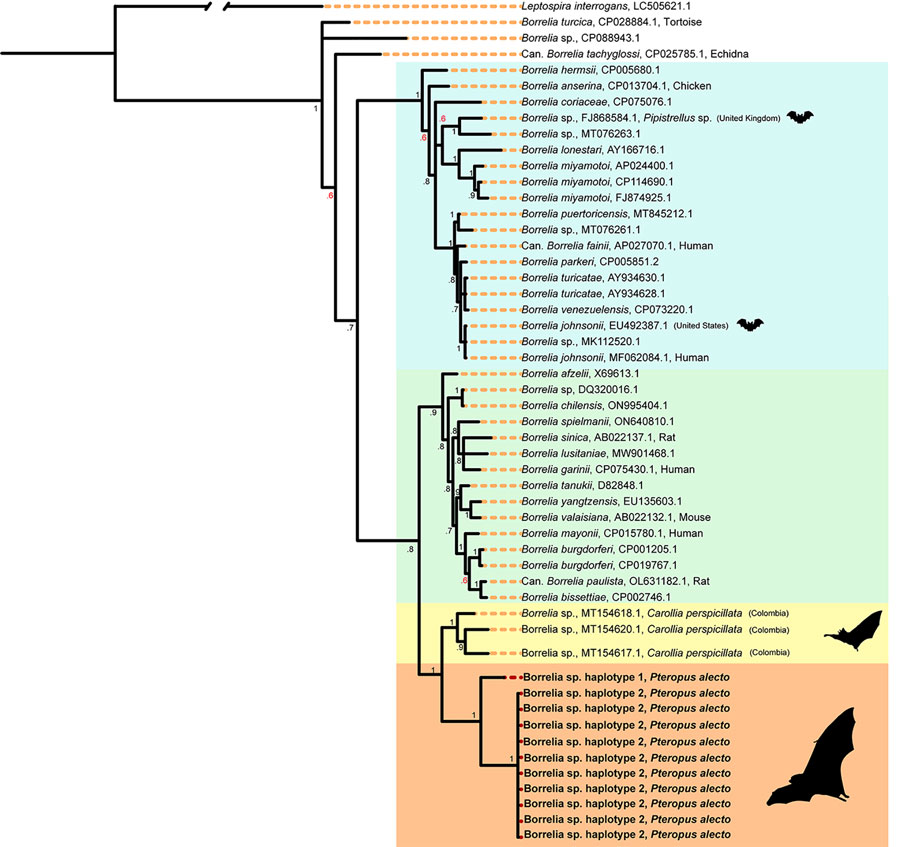Borrelia Lineages Adjacent to Zoonotic Clades in Black Flying Foxes (Pteropus alecto), Australia, 2018–2020
Taylor B. Verrett

, Caylee A. Falvo, Evelyn Benson, Devin N. Jones-Slobodian, Daniel E. Crowley, Adrienne S. Dale, Tamika J. Lunn, Manuel Ruiz-Aravena, Agnieszka Rynda-Apple, Clifton D. McKee, Kerry L. Clark, Alexander W. Gofton, Alison J. Peel, Raina K. Plowright, Daniel J. Becker, and
Bat One Health
Author affiliation: School of Biological Sciences, University of Oklahoma, Norman, Oklahoma, USA (T.B. Verrett, D.J. Becker); Montana State University, Bozeman, Montana, USA (C.A. Falvo, E. Benson, D.N. Jones-Slobodian, D.E. Crowley, A. Rynda-Apple); College of Veterinary Medicine, Cornell University, Ithaca, New York, USA (C.A. Falvo, D.E. Crowley, M. Ruiz-Aravena, R.K. Plowright); Texas Tech University, Lubbock, Texas, USA (A.S. Dale); Odum School of Ecology, University of Georgia, Athens, Georgia, USA (T.J. Lunn); Centre for Planetary Health and Food Security, Griffith University, Nathan, Queensland, Australia (T.J. Lunn, A.J. Peel); Mississippi State University, Starkville, Mississippi, USA (M. Ruiz-Aravena); Johns Hopkins Bloomberg School of Public Health, Baltimore, Maryland, USA (C.D. McKee); University of North Florida, Jacksonville, Florida, USA (K.L. Clark); CSIRO, Health and Biosecurity, Brisbane, Queensland, Australia (A.W. Gofton); Sydney School of Veterinary Science, University of Sydney, Sydney, New South Wales, Australia (A.J. Peel)
Main Article
Figure 2

Figure 2. Bayesian phylogenetic tree of flaB gene in a study of Borrelia lineages adjacent to zoonotic clades in black flying foxes (Pteropus alecto), Australia, 2018–2020. The tree displays evolutionary relationships between Borrelia spp. and Borrelia lineages from black flying foxes. The tree was constructed by using a general time reversible with a proportion of invariable sites and gamma distribution substitution model and 10 million Markov chain Monte Carlo generations. Colors represent major Borrelia groups and clades of interest: blue, relapsing fever group; green, Borrelia burgdorferi sensu lato complex; yellow, Borrelia spp. from Macaregua Cave, Colombia; light orange, new Borrelia haplotypes from black flying foxes in Australia. Red node text represents posterior probabilities <0.70. Host associations are noted when GenBank lineages were isolated from vertebrates, barring experimental infections. GenBank accession numbers are provided. Lineages associated with bats or bat ticks are marked with a bat graphic (sourced from Noun Project, https://thenounproject.com).
Main Article
Page created: May 09, 2025
Page updated: June 25, 2025
Page reviewed: June 25, 2025
The conclusions, findings, and opinions expressed by authors contributing to this journal do not necessarily reflect the official position of the U.S. Department of Health and Human Services, the Public Health Service, the Centers for Disease Control and Prevention, or the authors' affiliated institutions. Use of trade names is for identification only and does not imply endorsement by any of the groups named above.
